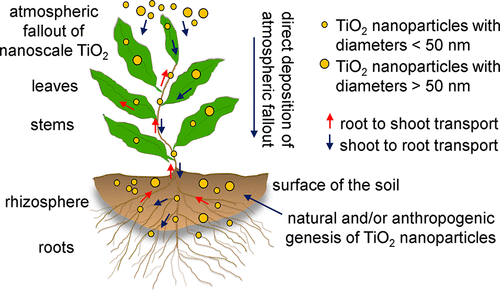当前位置:
X-MOL 学术
›
Environ. Sci. Technol.
›
论文详情
Our official English website, www.x-mol.net, welcomes your
feedback! (Note: you will need to create a separate account there.)
Size Fractionation of Titania Nanoparticles in Wild Dittrichia viscosa Grown in a Native Environment.
Environmental Science & Technology ( IF 10.8 ) Pub Date : 2020-06-15 , DOI: 10.1021/acs.est.9b07267 Bouchra Belhaj Abdallah 1, 2 , Irene Andreu 2 , Abdelwaheb Chatti 1 , Ahmed Landoulsi 1 , Byron D Gates 2
Environmental Science & Technology ( IF 10.8 ) Pub Date : 2020-06-15 , DOI: 10.1021/acs.est.9b07267 Bouchra Belhaj Abdallah 1, 2 , Irene Andreu 2 , Abdelwaheb Chatti 1 , Ahmed Landoulsi 1 , Byron D Gates 2
Affiliation

|
We report a size fractionation of titania (TiO2) nanoparticles absorbed from the environment and found within wild Dittrichia viscosa plants. The nanoparticles were isolated by extraction and isolation from distinct plant organs, as well as from the corresponding rhizosphere of wild, adult plants. The collected nanoparticles were characterized by scanning transmission electron microscopy coupled with energy dispersive X-ray spectroscopy (STEM-EDS). More than 1200 TiO2 nanoparticles were analyzed by these techniques. The results indicated the presence of TiO2 nanoparticles with a wide range of sizes within the inspected plant organs and rhizospheres. Interestingly, a size selective process occurs during the internalization and translocation of these nanoparticles (e.g., foliar and root uptake), which favors the accumulation of mainly TiO2 nanoparticles with diameters <50 nm in the leaves, stems, and roots. In fact, our findings indicate that among the total number of TiO2 nanoparticles analyzed, the fraction of the particles with dimensions <50 nm were 52% of those within the rhizospheres, 88.5% of those within the roots, 90% of those within the stems, and 53% of those within the leaves. This significant difference observed in the size distribution of the TiO2 nanoparticles among the rhizosphere and the plant organs could have impacts on the food chain and further biologicals effects that are dependent on the size of the TiO2.
中文翻译:

在原生环境中生长的野生铁皮粘菌中的二氧化钛纳米颗粒的大小分级。
我们报告了从环境吸收的二氧化钛(TiO 2)纳米粒子的大小分级,并发现在野生铁皮粘虫植物中。通过从不同的植物器官以及野生,成年植物的相应根际中提取和分离来分离纳米颗粒。收集的纳米粒子通过扫描透射电子显微镜与能量色散X射线光谱法(STEM-EDS)结合进行表征。通过这些技术分析了1200多种TiO 2纳米颗粒。结果表明存在TiO 2被检查的植物器官和根际内具有各种尺寸的纳米粒子。有趣的是,在这些纳米粒子的内在化和易位期间发生了尺寸选择过程(例如,叶和根的吸收),这有利于直径小于50 nm的主要TiO 2纳米粒子在叶,茎和根中的积累。实际上,我们的发现表明,在所分析的TiO 2纳米粒子总数中,尺寸小于50 nm的粒子所占比例为根际内的52%,根部内的88.5%,根部内的90%。茎和叶内茎的53%。在TiO 2的尺寸分布中观察到这一显着差异根际和植物器官中的纳米颗粒可能对食物链产生影响,并进一步影响生物学效应,这取决于TiO 2的大小。
更新日期:2020-07-21
中文翻译:

在原生环境中生长的野生铁皮粘菌中的二氧化钛纳米颗粒的大小分级。
我们报告了从环境吸收的二氧化钛(TiO 2)纳米粒子的大小分级,并发现在野生铁皮粘虫植物中。通过从不同的植物器官以及野生,成年植物的相应根际中提取和分离来分离纳米颗粒。收集的纳米粒子通过扫描透射电子显微镜与能量色散X射线光谱法(STEM-EDS)结合进行表征。通过这些技术分析了1200多种TiO 2纳米颗粒。结果表明存在TiO 2被检查的植物器官和根际内具有各种尺寸的纳米粒子。有趣的是,在这些纳米粒子的内在化和易位期间发生了尺寸选择过程(例如,叶和根的吸收),这有利于直径小于50 nm的主要TiO 2纳米粒子在叶,茎和根中的积累。实际上,我们的发现表明,在所分析的TiO 2纳米粒子总数中,尺寸小于50 nm的粒子所占比例为根际内的52%,根部内的88.5%,根部内的90%。茎和叶内茎的53%。在TiO 2的尺寸分布中观察到这一显着差异根际和植物器官中的纳米颗粒可能对食物链产生影响,并进一步影响生物学效应,这取决于TiO 2的大小。











































 京公网安备 11010802027423号
京公网安备 11010802027423号